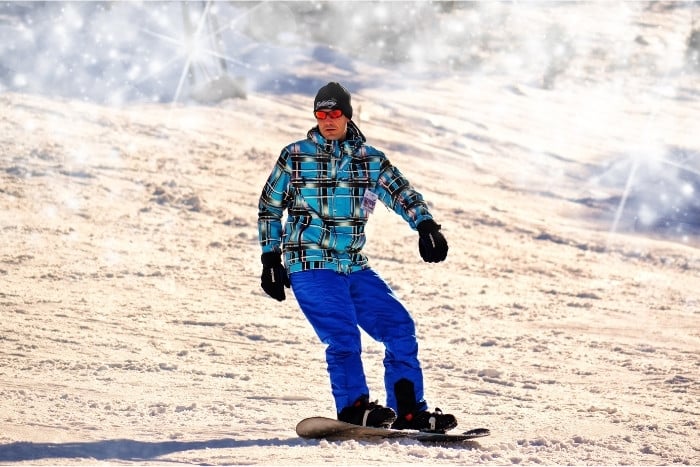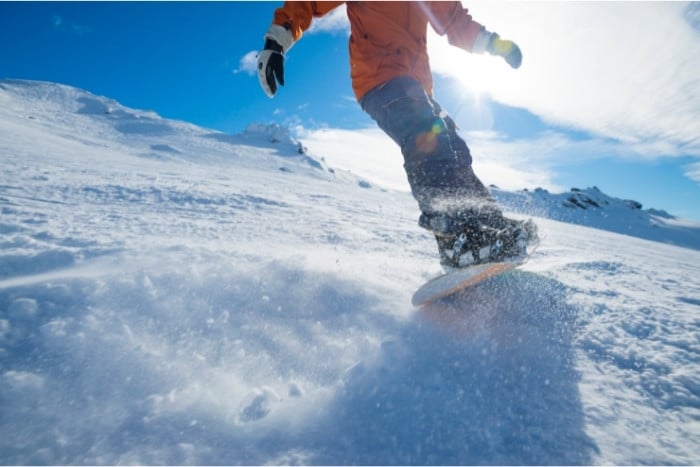If you’ve been shopping around for a new snowboard, you might have come across boards claiming to be asymmetrical. But what exactly do these boards do, and what are the pros and cons of this type of board?
An asymmetrical snowboard has some benefits for those who ride with a duck stance. With this stance, you’ll find that the board turns easier, is slightly more responsive, and is more comfortable to ride. There are no significant negative aspects to using an asymmetrical snowboard.
Below, we cover in detail the different types of asymmetrical boards as well as their benefits and drawbacks.
What Is an Asymmetrical Snowboard?
The human body is naturally symmetrical when split down the middle, in what is called bilateral symmetry.
If you draw a line down through your nose and belly button, you will see that each side is relatively the same.
However, when you stand sideways on a board, you lose that symmetry and adopt an asymmetrical stance.
Asymmetrical boards are designed to combat this, aiming to realign the body’s symmetry by tweaking the board’s design in an asymmetrical manner.
But, when riding sideways, the body’s shape is far from symmetrical, which often makes the differences between asymmetrical and symmetrical boards subtle.
Having a symmetrical stance helps a rider benefit from the asymmetrical board, as it further aligns their symmetry on the board.

Different Types of Asymmetry in Boards
There are a few different methods of obtaining asymmetry on a snowboard.
Before discussing the pros and cons of asymmetry in snowboards, the different types of asymmetry have to be discussed to give the most accurate picture of the board’s ability compared to symmetrical snowboards.
1. An Asymmetrical Sidecut
An asymmetrical sidecut is the most common type of snowboard asymmetry.
It refers to when the heel edge sidecut is deeper than the toe edge, which translates to having a shorter radius than that of the toe edge in practice.
You will only find asymmetrical boards with a deep heel edge side cut, as this helps to symmetrically align the body on the board.
2. Asymmetrical Contact Points
Asymmetrical contact points are often, but not always, applied alongside an asymmetrical sidecut.
These contact points are usually subtle, with the heel edge contact points being closer to the center of the board and the toes edge contact points slightly closer to the nose and tail of the board.
3. Asymmetrical Board Flex
Snowboards can also have an asymmetrical flex, with a softer flex towards the board’s heel edge than the board’s toe edge.
This complements asymmetrical sidecuts in snowboards, strengthening its advantages overall.
Pros of an Asymmetrical Board
Many don’t report seeing any distinct benefits from an asymmetrical board. However, if you ride with a duck stance, you’ll likely see some benefit from riding one.
However, this is the only stance that benefits from using an asymmetrical snowboard.
All other stances may find that using an asymmetrical board doesn’t have distinct advantages or disadvantages.
1. Works Well with a Symmetrical Stance
Your stance dramatically impacts your ability to feel and benefit from an asymmetrical board.
Snowboarders riding any stance other than duck stance report minor benefits.
However, snowboarders who ride with their bindings set at positive and minus 15 degrees have found that the board responds well in turns and carves, particularly on the heel edge.
No one’s exactly sure why a duck stance benefits riding on an asymmetrical board.
But it’s thought that the stance’s symmetrical nature helps to align the body symmetrically, to create a mock symmetry on the board.
So if you have an asymmetrical board and are feeling little to no benefits from it, it may be best to set your bindings to a duck stance.
2. Aggressive Turning and Carving
When you’re using an asymmetrical snowboard, you might find that the heel side turns are made to be tighter, allowing for swifter and more aggressive turning and carving.
If you’re riding with a positive/ negative stance, you’ll likely see some benefits from the swifter turning.
It’s unknown why asymmetrical snowboards allow for more aggressive and responsive turning. Still, many people who ride these boards report this as a benefit.
3. Asymmetrical Flex Benefits
An asymmetrical flex enhances the already existing benefits found on asymmetrical snowboards, allowing for even tighter turning.
The board is designed to have a softer flex on the heel side, which makes it easier to control, improving all the benefits of using an asymmetrical snowboard.
Beyond the turning enhancements, there are no distinct benefits to be found when it comes to having asymmetrical flex on your snowboard.
4. Easier Body Positioning
Many riders also report that riding an asymmetrical snowboard is more comfortable than a symmetrical board, as their body is positioned slightly differently on the board.
This is because you don’t have to shift your weight as far forward on these boards.
It allows you to carve with your weight centered directly on the board when you’re turning with your heel edge, which helps you to avoid falling.
It’s more comfortable for you with the correct stance and allows for an easier time controlling the board.
5. Responsive Heel Side Turns
You might have noticed when implementing heel side turns that getting into a tight turn and a low carve is challenging.
When carving down the mountain on a fresh pow day, getting in some deep turns on your toe is much easier.
Asymmetrical boards help rectify this by attempting to realign the body’s symmetry, equalizing the amount of force needed to turn for each side.
It doesn’t make them one hundred percent equal, but you will notice a difference in the responsiveness of your heel side turns.

Cons of an Asymmetrical Snowboard
There are no significant cons to an asymmetrical snowboard.
This is because an asymmetrical board only produces slight benefits provided your ride with a duck stance.
If you don’t ride with this stance, you likely won’t see any significant upsides to using an asymmetrical snowboard.
Buy, you also likely won’t see any significant downsides.
Not having the right stance on an asymmetrical snowboard can only lead to a neutral outcome, where you don’t feel any significant benefits or drawbacks.
You might find it a bit more uncomfortable if you don’t have the correct stance.
Still, it’d only be a slight difference compared to a regular snowboard, so it’ll unlikely significantly impact your riding.
Instead, you’re likely to find that an asymmetrical snowboard rides very similarly to a regular snowboard, without any noticeably significant differences in its feel and overall design.
It’ll feel similar to riding a symmetrical snowboard, as the differences are barely visible to the naked eye and aren’t likely to have a substantial impact.
Final Thoughts
Asymmetrical snowboards work by attempting to realign the body’s symmetry when riding sideways.
Other than small tweaks to the board’s design, asymmetrical boards don’t have many major differences compared to symmetrical snowboards.
If you use a duck stance, you’ll likely find benefits in how the snowboard turns, allowing for quicker and more aggressive turning, particularly on heel side turns.
If you don’t use a duck stance, you’ll likely find that the board is relatively regular in its mechanics and without any noticeable differences compared to a symmetrical snowboard.
There are no significant drawbacks to using an asymmetrical snowboard.
